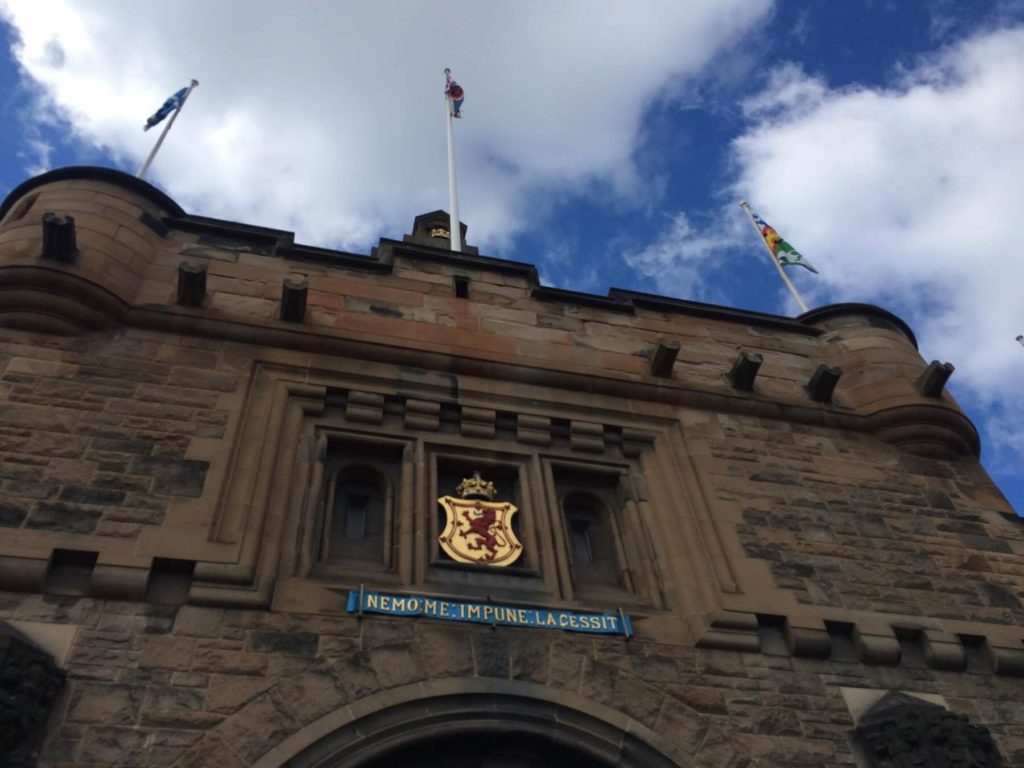
Scotland is home to scotch and spirits of another type – ghosts. Edinburgh Castle is one of the most haunted places in Scotland. It has a history of darkness, torture, and death.
Contents
History of Edinburgh Castle
The history of the castle began millions of years ago – given its unique location on “Castle Rock.” Before humans roamed the earth, this location was an active volcano. Edinburgh Castle is actually built on the top of the “plug” of the now-extinct volcano.

Prehistory through 1400
There is evidence of habitation of humans from as long ago as 1 AD. In fact, there are several Welsh works that reference Castle Rock as the site of great wars and destruction. The hill has long-seen conflict and turmoil.
The beginnings of a castle began around the year 1000. Historians believe that two structures were built, including a chapel, that is still the base of the now-known Marget Chapel.
In 1296, the first war of Scottish independence occurred here. The case was under siege and eventually came under English control. The wars didn’t stop there. In 1335 the second war of Scottish independence occurred here. The English secured the castle, but many lives were lost again.
In the 1400s, children from the Douglas family, William (16) and David (10), were summoned to the castle for what history remarks as the Black Dinner. Afterwards, the two children were executed by the 10-year-old English King. Supports of the Scottish Douglas family then sieged the castle, with more lives lost.
Middle Ages
In the 1500s the castle expanded, and so did the deaths and destruction. Numerous sieges and civil wars broke out between the Scottish and English with Edinburgh Castle at the center of it all. At one point, even the well that fed water to the monarchs was poisoned.
In 1573 a major destruction occurred. Two towers of the castle fell, thousands of civilians were murdered, and soldiers died defending the castle.
In the 1600s the castle was reinforced and turned into a fortress with a prison. Religious disputes marked the castle grounds with the blood of many civilians and soldiers. OFor the next few hundred years, the castle held prisoners of war from the Seven Years’ War, American Independence, and the Napoleonic Wars.
Modern History

Since the 1800s the castle has been a prison and a palace. While less war-related conflict has occurred since the middle ages, there is still significant death.
In the early 1800s 40 prisoners escaped the castle. After this mass-prison break. The castle became a national monument and museum. Several buildings were restored, St. Margaret’s Chapel was re-taken after spending time as a shop, and the towers were restored.
During the world wars, the castle again resumed its role as a prison. Some inmates included German pilots who crashed, as well as other military officials.
Today, Edinburgh Castle is a historic monument that tourists can visit. But it is also home to thousands of spirits who have died over the past 1000+ years.
Hauntings at Edinburgh Castle
There are a number of rumored hauntings at Edinburgh Castle. These are some of the most well-known ghosts that haunt Edinburgh Castle.
The Pushy Prisoner

When Edinburgh Castle acted as a prison, one of the prisoners decided to take deep dive into human waste. He believed that he could wait in the vile, then when it was dumped he would run away.
What he didn’t know was that the human waste was flung off a nearby cliff. When the waste was thrown, so was the prisoner. He crashed onto the rocks below to his death.
The inmate still haunts the hills. Visitors swear that smell a rotten, foul odor right before they are nudged from behind while peering over the side of the castle.
Headless Drummer Boy
One of the older-known sightings is that of a headless drummer boy. Writings of this spirit go as far back as the 1600s. Castle soldiers would report hearing a drum go off and seeing a headless child pounding drums.
The headless drummer boy was a helpful ghost. He would pound his drums shortly before an attack. Soldiers who spotted the boy would alert others of potential danger.
Bagpipe Boy

What many people don’t know is that there are a series of underground tunnels below the castle. A long time ago a little boy who played the bagpipe was sent down to investigate the tunnels on his own. People told him to play his bagpipe so that they could keep track of him.
Unfortunately, the labyrinth of tunnels was too difficult to navigate in the dark with a bagpipe. Onlookers suddenly heard the bagpipe go silent and the boy was never seen again. Today, workers report hearing faint bagpipe sounds emanating from below the castle floors, especially on cold nights.
King Malcolm III’s Widow

In the year 1093 when two stone structures laid on Castle Rock, King Malcom III of Scotland died. His widow, Margaret, who lived at the castle, found out that her partner had died. Within a few days she “died of grief.” Meanwhile, the deceased King’s brother sieged the castle.
Workers at the castle describe a woman wailing with grief and sorrow late in the night. The wailing gets more frequent in November when Margaret heard the news of her late partner.
Fighting Soldiers

Edinburgh Castle is known as the most besieged place in Great Britain. The ghosts who are still active here may still be attacking the castle.
Shadowy figures can be seen charging the grounds, while passersby experience sudden drops of temperature on the grounds and eerie mists. Some visitors even claim that their clothes are being tugged on.
Lady Glamis (Janet Douglas)

Lady Glamis was a Scottish noblewoman who was accused of witchcraft in the 1500s. Workers built a scaffold specifically for her alleged crimes. She was burned at the stake while her son watched her horrible death.
Today, she is known as the weeping gray lady who drifts through the castle wailing in despair. People also hear hammers as she passes by, arguable the sound of those who built her scaffold. She relives her horrible death and weeps through the halls.
FAQ
Is Edinburgh Castle haunted?
Yes, Edinburgh Castle is haunted by several ghosts. When you visit keep your guard up for foul odors, eerie mists, and phantom sightings.